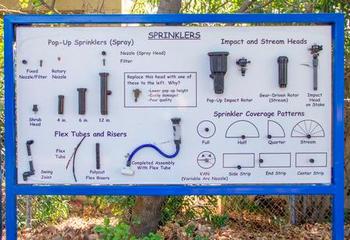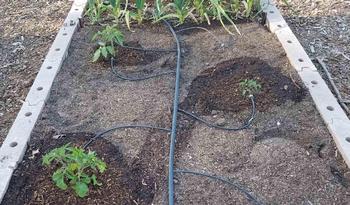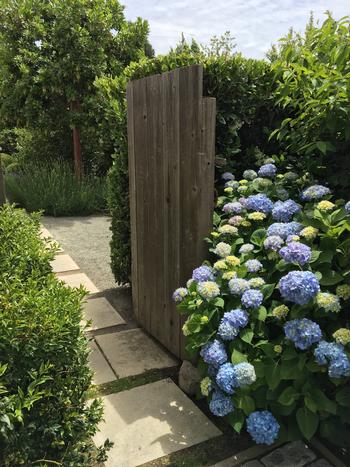Irrigation: How much, how often?
-
Diane Lynch
-
The early months of the year, when we hope for abundant rain and have watering systems turned off, are the best times to consider maintenance, changes, or installing a new watering system for your garden.
 A sprinkler irrigation display board at Fair Oaks horticulture. Photo: Melissa Womack
A sprinkler irrigation display board at Fair Oaks horticulture. Photo: Melissa WomackDrip irrigation, which is how most of us should water our gardens (except for lawns, which are challenging to justify in our arid climate), is a snarl of small and larger lines all over the garden. Rodents like to chew on them; the sun isn’t great for longevity, and they’re intended to put out tiny amounts of water. What’s not to love?
Seriously, with a drip system, water can be placed accurately and applied slowly with less waste. Plants benefit from not having wet foliage, which can encourage fungal diseases, and you can work in the garden when the system is on. Once you’ve made the considerable investment, your system should be good for years, with occasional repairs.
Drip irrigation is about 90% efficient because a well-installed system puts the water right where it’s needed. Spot watering isn’t as efficient, but it has the benefit of having the gardener (you!) observe how plants are doing. Overhead sprinklers, used to irrigate lawns, are subject to interference from shrubs and mist evaporation. Drip irrigation offers several advantages. Water is slowly placed more accurately in the root zone, so there is little or no waste. Photo: Courtesy
Drip irrigation offers several advantages. Water is slowly placed more accurately in the root zone, so there is little or no waste. Photo: CourtesyProperly installed and maintained, drip irrigation systems will do a good job of keeping your plants properly hydrated. Vegetables, especially, need consistent water during their growth cycles. Tomatoes and peppers will suffer and be prone to blossom end rot and other maladies if not kept consistently irrigated.
How to figure out how much water to give your garden? Time it as you fill a straight-sided gallon vessel to the top, and you’ll know the water flow rate. A gallon of water will hydrate a square foot of soil to 1.6 inches. Some variables include existing moisture and soil texture (clay soil will dampen much more slowly than sandy loam, for instance); slope can affect absorption. You can figure out the weak points in your sprinkler system for lawns by putting tin cans out and timing how long it takes to get the desired amount of water to a given area. This will reveal spots that need more (or less) water. Ideally, you’d know the approximate depth of the roots on your plants and group them by water need according to depth, but this is unlikely to be practical in most gardens. This hydrangea may need more water than the shrubs surrounding it, but if it’s well-established, it may do ok on the same amount of water..
This hydrangea may need more water than the shrubs surrounding it, but if it’s well-established, it may do ok on the same amount of water..Soaker hoses can supplement an installed system when more water is needed. Hoses under 25’ on level land can add additional water where required in extreme drought or newly planted areas that need additional water to get started.
Some gardeners like to install and manage their own irrigation systems, but for many, it makes sense to have a professional do the installation and an annual check in the spring to make sure emitters are working and leaks are fixed before turning on the system for spring, summer, and fall. The amount of water needed will vary with day length and temperature, so come fall, the garden will need less water, and the timers can be adjusted to account for this.
Happy irrigating!



